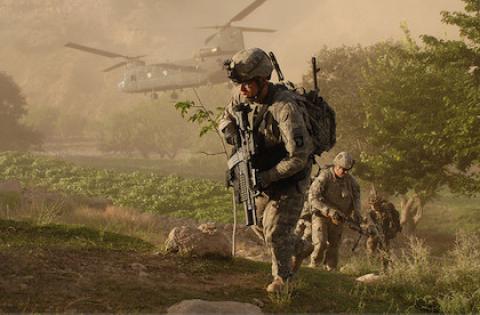During the Christmas-New Year period, President Barack Obama formally announced the end of America’s longest war, fought over thirteen years in Afghanistan. The invasion of that country was ordered by his predecessor, George W. Bush, following the 11 September 2001 attack on the United States. Obama called it the “responsible conclusion” of the Afghan war. Claiming that the United States was more secure, he thanked American troops and intelligence personnel for their “extraordinary sacrifices,” but acknowledged that Afghanistan remained a “dangerous place.”
The central point in these comments is that Afghanistan continues to be a dangerous place, radiating its woes beyond its frontier. A few hours earlier in Kabul, the end of NATO’s “combat mission” was marked at a ceremony held in secret because of fears of a Taliban attack. Retired Air Commodore John Oddie, former deputy chief of the Australian contingent in Afghanistan, described the secret ceremony as a “sad commentary.” Oddie has grave doubts over the Afghan forces’ capacity to secure the nation.
The year 2014 was the bloodiest since the Americans returned to Afghanistan in October 2001 and the Pashtun-dominated Taliban regime in Kabul was overthrown. The number of civilian casualties reached nearly ten thousand in 2014; five thousand Afghan soldiers were killed. These figures tell the story of Taliban resurgence and that they are stronger than at any time since their removal thirteen years ago. They control large parts of Afghan territory. Even in the capital, hardly any place is beyond their reach.
More than a hundred and thirty thousand foreign troops were deployed across Afghanistan at the peak of the US-led operation to eliminate the Taliban threat. America has failed in this respect, leaving the government in Kabul vulnerable. The NATO mission’s end was announced with claims laced with optimism. Western officials praised the dedication and bravery of Afghan security forces, whose official strength is around three hundred and fifty thousand.
It is claimed that they are capable of continuing a strong fight against Taliban and al-Qaida elements. Given the last year’s record, however, the assertion is not a credible. Internal rivalries have delayed the formation of a full cabinet three months after the inauguration of Ashraf Ghani as president and his rival, Abdullah Abdullah, as chief executive. Vacuum in the Defence and Interior ministries is a cause of worry.
The end of the US combat mission is a point worth reflecting on how the Soviet Union’s decade of occupation of Afghanistan came to the conclusion in February 1989 and its consequences to date. The strength of the Soviet occupying forces at the peak was similar to American-led troops this time. The Soviet aim was to defeat the anti-communist Mujahideen militias and protect the pro-Moscow government in Kabul.
In an intense final phase of the cold war, the Carter and Reagan administrations in Washington decided to confront Afghan and Soviet communism in the most cynical way, with little forethought of, and regard for, possible consequences. The Soviet Union lost, but then the same Islamist groups befriended by Washington mutated into the Taliban militia; with their al-Qaida allies, the Taliban became America’s deadly enemies.
Fortunately for the United States, Russia was helpful in Washington’s war against the Taliban and al-Qaida. Even so, after thirteen years of bombing, drone attacks, extra-judicial killings and torture, America’s resolve has come to an end. Washington will leave just a few thousand troops in Afghanistan to “advise and support” a beleaguered government.
It is also worth remembering at this stage how America’s Vietnam war ended? In a speech at Tulane University on 23 April 1975, President Gerald Ford announced that the Vietnam War was finished as far as America was concerned. Ford made a painful admission saying: “Today, Americans can regain the sense of pride that existed before Vietnam.”
US combat forces retreated despite the South Vietnamese regime pleading for fulsome US support as the North Vietnamese surrounded Saigon. A month before President Ford’s announcement, the North Vietnamese had launched a big offensive on Ban Me Thuot, the provincial capital of Darlac province. Following the South Vietnamese losses in that battle, America’s resolve had finally come to an end.
President Obama’s reference to the “responsible conclusion” of America’s combat operation has a similar echo. The government in Kabul is besieged. The Taliban can attack targets in the capital and almost anywhere else at will. Years of drone attacks, Guantanamo, and Osama bin Laden’s killing in Pakistan, have not defeated the Taliban. The year 2014 was still the worst of America’s thirteen year war.
The main factor behind fewer casualties among US-led foreign forces was that Afghan troops had been deployed to fight the opposition while occupation troops were largely confined to their bases. This, too, reminds of the 1980s, when Soviet forces previous to their withdrawal stayed in their barracks. Afghan government troops took heavy casualties.
With most of the Americans gone home, leaving behind a fractured pro-US government in Kabul dependent on dollar assistance, greater conflict and political uncertainty loom. The numbers of non-Pashtun troops, from Tajik and other ethnic minorities, are disproportionately high in the Afghan military – a country where ethnic Pashtuns are dominant. The government in Kabul will face serious challenges, both internal and external, in 2015.
As battlefield pressures grow, the government and the military will struggle with their own internal contradictions. Afghanistan has a history of constitutional governments being overthrown by coups. So the question remains whether the Afghan military, with a history of volatility and ethnic rivalries, has changed enough to be a united force committed to defending the elected government and the existing constitutional structure in the country.
[Deepak Tripathi is a writer with a particular reference to South Asia, the Middle East, the Cold War and America in world. He is a fellow of the Royal Historical Society and the Royal Asiatic Society of Great Britain and Northern Ireland. He is the author of Imperial Designs. He can be reached at: deepak.tripathi.writer@gmail.com.]


Spread the word